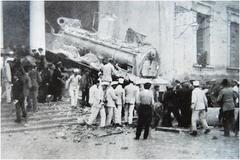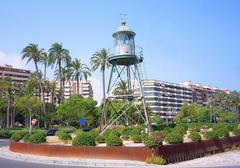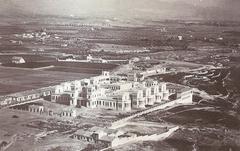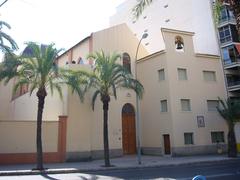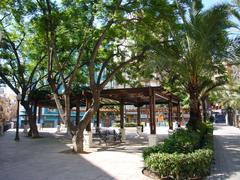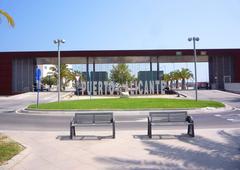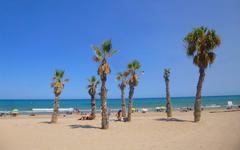Torre Plácida Alicante: Visiting Hours, Tickets, and Historical Site Guide
Date: 14/06/2025
Introduction to Torre Plácida in Alicante
Torre Plácida is a striking testament to Alicante’s layered history and enduring resilience. Erected in the 16th century to defend the region against Mediterranean pirate incursions, this watchtower is emblematic of the “Torres de la Huerta” network—fortified structures that once protected both the coastline and the fertile agricultural plains of Alicante (eleconomista.es; What Alicante). Nestled in the San Juan district, Torre Plácida fuses utilitarian military architecture with the region’s agrarian traditions, reflecting centuries of community vigilance and adaptation.
This guide delves into Torre Plácida’s historical and cultural context, architectural features, current conservation, and practical visitor information—including opening hours, ticketing, accessibility, and travel tips. It also highlights nearby attractions and offers answers to frequently asked questions, ensuring that every visitor can make the most of their experience.
Table of Contents
- Introduction
- Historical Background and Architecture
- Preservation and Community Value
- Visiting Torre Plácida: Hours, Tickets, and Practical Information
- Nearby Attractions and Suggested Itineraries
- FAQs
- Conclusion and Further Resources
Historical Background and Architecture
Origins and Defensive Role
Constructed during a period of intense maritime insecurity, Torre Plácida was part of a coordinated network of towers designed to protect Alicante’s inhabitants and agricultural wealth from Barbary pirate raids (Mapcarta). Its location near the historic Huerta de Alicante—once a thriving agricultural expanse—underscores its dual role as both lookout and refuge.
The tower was likely named after an early proprietor, following the tradition of local tower-naming. Over centuries, Torre Plácida has witnessed the transformation of Alicante from rural farmland to a vibrant urban area, while remaining a symbol of the city’s historical continuity.
Architectural Features
Torre Plácida exemplifies Alicante’s coastal defensive architecture:
- Materials: Local stone and lime mortar for durability.
- Structure: A circular or oval plan with thick masonry walls (often over one meter thick).
- Height: Generally around 12 meters, enabling wide surveillance.
- Entrances: Elevated, accessed by ladder or removable stairs, enhancing security.
- Defensive Elements: Parapets and limited external openings; small windows for observation and defense.
- Communication: The roof served as a platform for smoke or fire signals, allowing for rapid alerts to nearby towers and the Castillo de Santa Bárbara (What Alicante; guiacastillosalicante.blogspot.com).
While primarily functional, the tower’s design contains influences from both Moorish and Christian architectural traditions, seen in the use of geometric patterns and robust masonry.
Preservation and Community Value
Torre Plácida is recognized as a Bien de Interés Cultural (BIC), the highest heritage protection in Spain (eleconomista.es). Recent urban development threatened its survival, but rather than demolish the tower or surrounding homes, local authorities undertook a complex, stone-by-stone relocation. This unprecedented conservation effort preserved both the structure and its historical context.
Local communities and heritage associations have played a critical role in advocating for Torre Plácida’s preservation, ensuring that it remains not only a monument but also a living part of Alicante’s cultural identity (alicanteturismo.com; guiacastillosalicante.blogspot.com).
Visiting Torre Plácida: Hours, Tickets, and Practical Information
Opening Hours and Ticket Information
- Standard Hours: Tuesday to Sunday, 10:00 AM to 6:00 PM (closed Mondays and public holidays).
- Admission: General entry is €5, with reduced rates (€3) for seniors, students, and groups. Children under 12 are free.
- Guided Tours: Available on weekends at 11:00 AM and 4:00 PM; advance booking is recommended.
- Special Events: Open days and cultural festivals may offer free entry or special programs (SpainMadeSimple).
Accessibility and Guided Tours
- Location: San Juan district, easily reached by bus (lines 21 and 22) or car; parking available nearby.
- Accessibility: Wheelchair-accessible ramps and adapted facilities are provided, though some uneven surfaces exist.
- Guided Tours: Enhance your visit with expert-led tours, available in multiple languages. Some include visits to other Torres de la Huerta.
Visitor Tips
- Best Time to Visit: Spring and autumn for mild weather and fewer crowds.
- Photography: The tower and surroundings provide excellent photo opportunities, especially at sunrise or sunset.
- Amenities: Cafés, restrooms, and tourist information centers are available in the vicinity.
- Safety: Alicante is generally safe; keep valuables secure in busy areas (HikersBay).
Nearby Attractions and Suggested Itineraries
Torre Plácida is ideally situated for exploring Alicante’s rich historical landscape. Notable nearby sites include:
- Castillo de Santa Bárbara: Alicante’s iconic hilltop fortress (SpainMadeSimple).
- Explanada de España: A palm-lined promenade perfect for strolling (TravelTomTom).
- Basilica of Santa María: The city’s oldest church, featuring Gothic architecture (Spainist).
- Mercado Central: A lively market for local delicacies.
A half-day itinerary might include Torre Plácida, a walk along the Explanada, a visit to the castle, and lunch at a local tapas bar.
Cycling enthusiasts can follow the “Torres de la Huerta” route, which links several historic towers and fincas in the Alicante countryside (Spain Cycle Touring).
Frequently Asked Questions (FAQs)
Q: What are Torre Plácida’s opening hours?
A: Tuesday to Sunday, 10:00 AM to 6:00 PM; closed Mondays. Hours may vary for special events.
Q: How much is admission?
A: General entry is €5, with discounts for seniors, students, and groups. Children under 12 are free.
Q: Are guided tours available?
A: Yes, on weekends at 11:00 AM and 4:00 PM.
Q: Is Torre Plácida accessible for visitors with disabilities?
A: Yes, ramps and adapted facilities are available, though some outdoor surfaces are uneven.
Q: How do I reach Torre Plácida?
A: By public bus (lines 21 or 22) or by car; parking is available nearby.
Q: Can I buy tickets online?
A: Yes, through official Alicante tourism websites and at local visitor centers.
Conclusion
Torre Plácida stands as a meaningful link between Alicante’s medieval past and its vibrant present. Its robust architecture, fascinating history, and successful conservation make it a must-visit for anyone exploring Alicante’s cultural heritage. Whether you’re interested in defensive architecture, rural traditions, or simply seeking a unique viewpoint over the city and coast, Torre Plácida promises an enriching and memorable experience.
For up-to-date information on visiting hours, tickets, and guided tours, download the Audiala app and follow local tourism resources. Explore the full breadth of Alicante’s rich heritage by including Torre Plácida in your itinerary.
References & Further Reading
- Mapcarta: Visiting Torre Plácida
- eleconomista.es: Cultural and Historical Significance of Torre Plácida
- SpainMadeSimple: Torre Plácida Visiting Hours & Tickets
- Spain Cycle Touring: Torres de la Huerta
- Alicante Tourism Official Website
- What Alicante: Medieval Architecture and History
- guiacastillosalicante.blogspot.com: Torre Plácida
- TravelTomTom: Alicante Travel Tips
- Spainist: Alicante Attractions
- HikersBay: Alicante Tourist Information
- Mar Alicante: Best Times to Visit
- Splendidly Spain: Things to Do in Alicante
- Built Heritage: Defensive Rural Architecture
